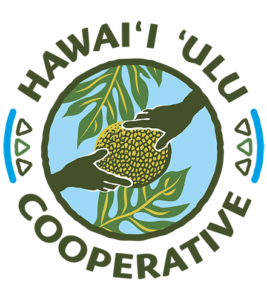2-Year Anniversary Blog – OK Farms Agroforestry Project
Learn about our journey on starting this 5-acre agroforestry demo plot at OK Farms and the progress made in the first 2 years. Starting in May 2022, OK Farms and the Hawai‘i ‘Ulu Cooperative have teamed together with Propagate Ventures LLC on ground-proofing a large scale agroforestry installation combined with their innovative software, Overyield. Check out our progress video and read more below for details on what we have planted so far, what we learned in the process, and our harvest totals in only the first two years!
As we mark the two-year anniversary with our collaboration project at O.K Farms, we’re excited to share the journey we’ve taken so far to establish a successful agroforestry demonstration site and build community through volunteer engagement. We’ve achieved results that highlight our dedication to sustainable food production, ʻulu agroforestry, and building meaningful community connections. In the past year, we’ve reached important milestones in our crop production, listed below is our current crop establishment.
Total Crops Planted as of May 2024
- ‘Ulu (Breadfruit) – 200
- Kalo (Taro) – 5,982
- Coffee – 1,528
- Mai’a – 25
- Māmaki – 52
- Kō (Sugarcane) – 984
We are excited to mention that our efforts in the establishment phase at O.K. Farms have also produced a successful harvest of:
- Over 1,000 lbs of kalo (taro) corm
- 300 lbs of kalo (taro) leaves
- over 500 lbs of popo ‘ulu bananas, and 50 lbs of pala’ai
These accomplishments could not have been made without the collaboration of over 200 dedicated volunteers that have helped each month to plant, mulch, weed, maintain and harvest our field.
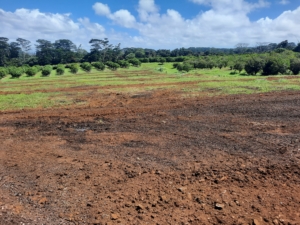
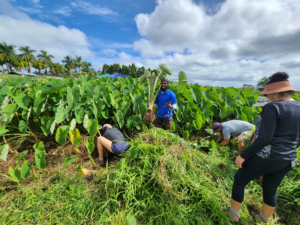
A picture of the farm just after clearing (left) and 1 year after planting (right) – previously this was a commercial rambutan orchard like the trees in the background.
Read more about our initial partnership with OK Farms and Propagate’s software System, Overyield, in our first blog – ‘ULU AGROFORESTRY TAKES ROOT AT O.K. FARMS
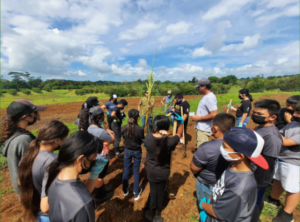
OK Farms manager Troy Keolanui, showing local Kamehameha Schools students how to plant a local variety of mai’a (banana)
Agroforestry Planning and Establishment – What We Learned
Today, the USDA National Agroforestry Center recognizes a variety of agroforestry techniques, you can learn more about implementing these successfully on your farm by reading the ‘Ulu Co-op’s Guide to ‘Ulu Agroforestry in Hawai’i.
The planning process of this site helped to develop our ʻUlu Production Primer which was designed to help local farmers plan, implement, and maintain a productive and sustainable agroforestry system – using breadfruit as a cornerstone species. At the OK Farms trial site we are implementing the following crops and agroforestry practices:
- Fast growth cycle (harvest in under one year): kalo (taro), hibiscus
2. Medium growth cycle (harvest in 1–2 years): kō (sugarcane) , mai’a (banana), māmaki, cassava.
3. Slower growth cycle (maturity in 4-5 years+): coffee and ‘ulu (breadfruit).
The demonstration agroforest at O.K. Farms was designed primarily around alley cropping and windbreak systems, and also included components of multi-story cropping.
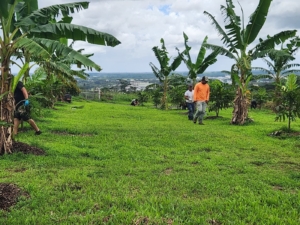
Ulu (breadfruit) and mai’a (banana) interplanted within rows at the top portion of the plot
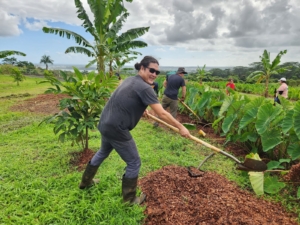
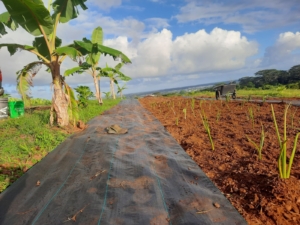
Alleys of kalo (taro) grown between rows of interplanted ulu (breadfruit) and mai’a (banana) – see the smiles of volunteers as they help us to tend the kalo patch! Check out HUC’s Kalo Production Guide for more information on the specifics of growing kalo in Hawaii Growerʻs Guide to Upland Kalo.
Changes from the Initial Plan
We learned a few things during our process of executing the design for this plot that changed from our initial plan:
- Removal of pumpkin/survival of mamaki: Proper timing is key- at first we had planted a large section of pala‘ai (squash) and mamaki separately in the plot. However, these areas did not receive proper preparations to ensure a productive crop and we ended up losing the majority of what was planted due to exposure to the elements and lack of water.
- Addition of more coffee: The number of coffee plants was increased at this site in order to increase the revenue provided by the 5-acre plot until the breadfruit matures. Considering investment costs and revenues is an important part of any successful farm – adding more coffee plants allows this plot to be financially productive in the coming years when the breadfruit is still immature.
- Expansion of kalo: The quantity of planted kalo was also increased. Working with community partners has allowed OK Farms to plant and maintain a significant portion of the farm in various native kalo varieties.
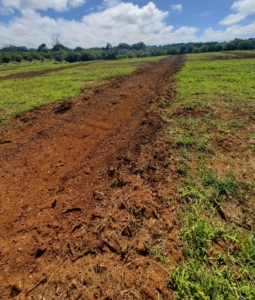
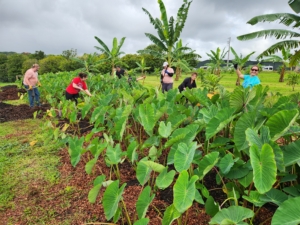
The land cleared after removal of rambutan rows (left) and new plantings thriving (kalo, mai’a, and breadfruit) with help from our volunteers one year later
Community Work Days
In June 2024 the Ulu Coop and O.K farms celebrated the two year anniversary of the project starting with a work party volunteer day which occurs on the last Saturday of every month to involve local farmers and community members interested in helping and learning more about agroforestry by helping within an already established model. The work day was also enjoyed with a potluck meal and live music provided from Coop staff and members of the community. Please see our social media @HawaiiUluCooperative to get info on our upcoming volunteer opportunities and SIGN UP HERE for a chance to join us in loving the land and talk story with our neighbors on our shared experiences growing food.
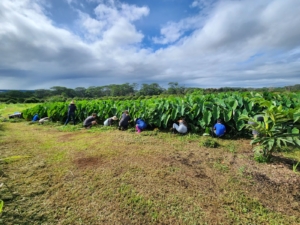
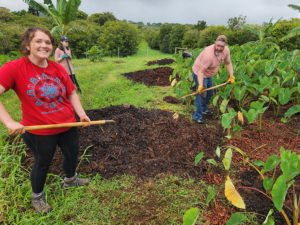
A group of kama’aina volunteers helping to malama aina during our first kalo harvest – which produced over 600 lbs of fresh corm and leaf!
Interested in Implementing Agroforestry On Your Farm? Funding Opportunities:
The Hawaiʻi Climate-Smart Commodities (HiCSC) Project seeks to establish a partnership with farmers and agricultural service providers to implement a “portfolio” of climate-smart production practices, activities, and systems on working lands in Hawaiʻi. The project prioritizes diverse, multifunctional landscapes and targets known “lowest-hanging fruits” for maximum climate benefit through both sequestration and emissions avoidance. CLICK HERE for More Information
The Expanding Agroforestry Production & Markets for Producer Profitability and Climate Stabilization project is funded through the USDA’s Partnerships for Climate-Smart Commodities (CSC) initiative. In 2022, the USDA announced more than $3.1 billion in funding for 141 projects, including $60 million for this national agroforestry project. CLICK HERE for More Information
